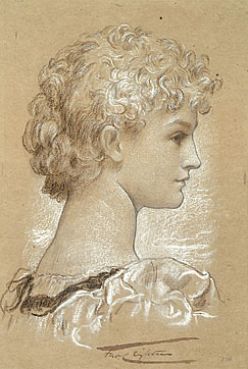The Clapham Society Local History Series — 15
In the Middle of Winter Flaming June Returns
by Alyson Wilson
This article first appeared in the South London Press on on 27 January 2017

One day in 1962 builders restoring a house on Clapham Common found a painting behind some panelling over a fireplace and took it in to an art and framing shop on Battersea Rise, thinking that the frame might be worth something. The painting was put in the window where the teen-aged Andrew Lloyd Webber spotted it and wanted to buy it, but he could not persuade his family to lend him the necessary £60. At that time Victorian pictures like this were much out of fashion. As a result of his successful musicals Lloyd Webber has subsequently been able to form a large collection of paintings of that period, but Lord Leighton’s masterpiece, Flaming June, had escaped to Peru. Now for the first time for over 50 years it has returned to London and can be seen at Leighton House Museum in Kensington until April.
Flaming June was one of six paintings sent to the Royal Academy Exhibition in 1895 by Frederic, Lord Leighton, a distinguished artist and President of the Royal Academy. The painting was not particularly well received at the exhibition, but soon became widely known because it was bought by William Luson Thomas the proprietor of The Graphic, a popular art publication. A free colour reproduction of the painting was included with the 1896 Christmas edition of The Graphic and readers could purchase a framed version of the painting for 10/- (50p).
A few years later the painting was sold to Blanche Watney, of the brewing family. It passed down in the family, on loan to the Ashmolean Museum, in Oxford for a while, and was in an exhibition at Leighton House to mark the centenary of Leighton’s birth in 1930. After that the work was not seen or heard of again until its reappearance in Clapham in 1962.
It was bought from the Clapham shop by a dealer and changed hands a few times before finishing up with West End art dealer, Jeremy Maas, who specialized in Victorian paintings. No public collection in the UK was interested in the painting which Maas finally sold in 1963 for £2000 to South American businessman Luis Ferre for his collection in the Muse de Arte in the Puerto Rican city of Ponce. There it stayed until an outing to an exhibition in New York in 2015, and now it has returned to London for a few months.

This painting has an interesting second Clapham connection. The model used by Lord Leighton for the painting was almost certainly his favourite model and muse, Dorothy Dene. This was the name taken by a young girl, called Ada Pullan, who lived in The Chase, just off Clapham Common in the 1880s. Her background was complex. She came from an upwardly mobile, working class family with ten children in east London. The family moved house frequently, but by 1881 both parents were dead and 21-year old Ada and two brothers were responsible for supporting their younger siblings. Career opportunities for women in those days were limited, but good-looking women were in demand as models for artists. In the 1881 census Ada is shown as an art student, although we know that she was already modelling for the Kensington circle of Pre-Raphaelite artists. Her introduction to Frederic Leighton is described in contemporary memoirs, which describe her delicate complexion, ‘a clouded pallor, with a hint somewhere of a lovely shell-pink’ and ‘pretty brown eyes, with long, curly lashes, delicately chiselled features, and an aureole of light golden hair.’
Ada Pullan had ambitions beyond modeling, and aspired to be an actress. In this she was encouraged and supported by Leighton, who probably suggested the change of name to a more memorable Dorothy Dene. Her acting career did not flourish, at least during Leighton’s life time. Although he did not know it at the time, Flaming June was one of his last paintings and the last time she modeled for him. When the painting was exhibited at the Royal Academy in 1895 Leighton was in North Africa in a vain attempt to restore his failing health. He died the following year, making generous provision for Dorothy Dene and her sisters in his will.
It is appropriate that this painting is now on view at the home of Lord Leighton, which was also his studio where it was painted. Leighton House is an exotic house built by this successful artist in a popular area for artists at the time. The special exhibition of Flaming June and various associated works runs until the end of April. Leighton House itself is fascinating and well worth a visit. For more details and opening times go to the leightonhouse website.
For more about Dorothy Dene see Article No 2 in this series.